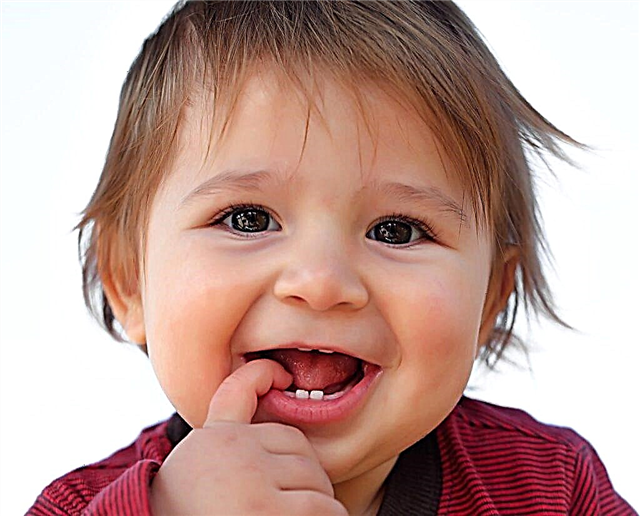Teething in children is a natural milestone in the development of a little man. Moms and dads are eagerly awaiting the appearance of the first teeth in babies, but this solemn event is often accompanied by unpleasant symptoms. For example, itching, painful sensations and even fever. But if you know how teeth are cut and what signs accompany this process, you can prepare for it and ease the baby's well-being with the help of folk remedies and medicines.
Timing and order of teething
The timing of the appearance of the first teeth is a purely individual indicator. Therefore, the answer to the question when the baby's teeth are teething will depend on many factors.
We list only the most basic ones:
- heredity;
- features of the development of the baby in the womb;
- the diet of a woman during the period of bearing a child;
- the time of the introduction of complementary foods and the features of the children's diet;
- ecological features of the place of residence of the family.
And yet, there are approximate dates for teething in children, approved by international and Russian organizations and are a kind of guidelines for doctors and parents.

According to this information, teeth in children are usually cut in the following order:
- central lower incisors - at the age of 6-8 months;
- upper incisors located in the center - 8-10 months;
- lateral incisors (top) - 9-13 months;
- lateral incisors (bottom) - 10-16 months;
- first molars located above and below - 13-19 months;
- canines on the upper and lower jaws - 16-23 months (these teeth are located closest to the ends of the optic nerve, which is why the most unpleasant symptoms, for example, pain and tearing, appear precisely with the growth of canines);
- second molars on the upper and lower jaws - 20-36 months.
How many milk teeth do children have by the age of three? By this age, the vast majority of babies, with rare exceptions, have a complete "set" of milk teeth in the amount of 20 pieces.
Let us clarify once again that this scheme is approximate, and the eruption of milk teeth in children is a purely individual process. But if the sequence of the appearance of canines, incisors and molars is violated, or they come out much later than the announced dates, you should consult a doctor. He examines the baby and confirms or excludes the presence of diseases. For example, rickets, endocrine pathologies.
Teething symptoms
So, the scheme of teething in children is clear, you can keep it in your head while watching your own baby. Although in any case, parents will not be able to skip this process, since it is accompanied by several characteristic and unpleasant signs.
It:
- swelling and redness of the gums;
- increased salivation;
- itching of the gums (it begins to manifest itself by the fact that the baby pulls nearby objects into his mouth);
- painful sensations;
- slight increase in temperature;
- slight runny nose;
- rare cough;
- loose and frequent stools;
- decreased appetite;
- sleep problems;
- vomiting (it is rare, usually due to the fact that mucous discharge gets on the root of the tongue).
Often, the first teeth in infants are accompanied by an increase in body temperature. The appearance of this symptom is due to the fact that when the teeth erupt, the gums begin to become inflamed. Not very much, but the child's body feels it. As a result, the temperature rises somewhat in order to prevent the spread of infection and protect against adverse environmental factors.
A slight or short-term increase in temperature is a normal reaction of the child's body. If the indicators exceed 38 ° C, are observed for several days, are accompanied by symptoms such as severe vomiting, persistent diarrhea, then you should consult a doctor. It is possible that an infection has entered the child's body.
Gels to relieve symptoms
Of course, one does not need to think that all these signs will manifest en masse in one particular child. Some babies almost asymptomatically tolerate the appearance of the first teeth, swollen gums and increased salivation - that's the whole problem. The mothers of other babies, each milk tooth, is greeted as a personal enemy.
To relieve pain, inflammation and sensitivity of the gums, to protect the affected areas of the oral cavity from infectious pathogens, special local gels for gums during teething in children will help.
Consider what gels can be used if a child's teeth are teething.

Pain relievers
Anesthetic gels not only relieve pain, but also reduce the intensity of itching, including due to the cooling effect. Their main active ingredient is a local analgesic, most often lidocaine, less often benzocaine. When applying such gels, the positive effect is noticeable within a few minutes, although it does not last long.
The lack of gels based on analgesics is a high probability of allergies in babies. Including because of this, pain relieving gels are recommended for use from 12 months of age. Although it is for babies that the analgesic and cooling effect of the drug is so important.
In addition, you should be careful to use medications that contain lidocaine or benzocaine if the baby is fed with breast milk. Anesthetics, when in contact with the tongue, "freeze" it. As a result, it negatively affects the process of breastfeeding and swallowing milk.
With natural composition
Natural gels are great because they can be used from birth and on a regular basis. The main ingredients here are herbal extracts and oils that effectively and safely relieve inflammation, heal wounds (caused by combing the gums) and destroy pathogenic microbes.
You can read positive reviews about the Italian-made baby gum gel Dentinale Natura. It contains natural active ingredients:
- chamomile extract - helps relieve inflammation, accelerates the healing of irritated gingival mucosa of the baby;
- Boswellia extract - it has anesthetic and antimicrobial effects, also relieves inflammation;
- aloe vera juice - differs in pronounced antimicrobial properties.
This teething gel is free of synthetic anesthetics, sugars and parabens. Manufacturers specifically point out that its use is permissible from the first days of life. The kid will not protest against medical procedures, because Dentinale natura gel has a pleasant taste.
The application procedure itself is very simple. A small amount of the gel is squeezed onto a clean finger and applied with gentle movements to the children's gums. Frequency rate of application - up to 5 times a day. After application, it is not recommended to eat and drink for half an hour, so as not to prematurely remove the gel from the gums.

Anti-inflammatory drugs
With severe inflammatory processes, powerful agents based on choline salicylate are needed. This substance belongs to the group of antipyretics and analgesics, has a pronounced anti-inflammatory effect. When applying a gel with salicylic acid derivatives, itching and pain are reduced, edema disappears, and the risk of gum infection is reduced.
Of the minuses, we can note the fact that such drugs are allowed for use only after one year of age. This is due to a large number of contraindications and possible negative consequences.
Combined composition
In the pharmacy, you can buy gels that have a combined composition and demonstrate several therapeutic effects at once. They successfully stop the signs of teething: reduce soreness, heal combed gums, relieve itching and heal wounds.
But due to the presence in the composition of several active components of synthetic origin at once, the likelihood of allergic reactions is high. That is why you need to carefully study the packaging of the product, carefully observe the recommended doses. Well, the last advice applies to all drugs - you need to use them only after consulting a pediatrician.
How to help your child at home
The situation cannot be corrected with one drug. It is necessary to help the baby comprehensively.
- Massage your gums regularly... Before that, you need to thoroughly wash your hands, and then gently press on the swollen gums with your finger. After the procedure, you can apply gauze soaked in cool water to the swollen areas.
- Use teethers. These special devices, due to the liquid inside, can effectively relieve pain and itching. In addition, the child, "chewing" the teether, simultaneously massages the gums.
- Give solid fruits and vegetables. But not just like that, but after wrapping the product in gauze or putting it in a nibbler - a device with a mesh. Nibbling a carrot or apple, the baby trains the gums and at the same time is distracted from unpleasant itching.
If all else fails, and the gums are severely inflamed, it is imperative to consult a doctor. He will examine the child, determine the source of the problem (infection of the mucous membrane cannot be ruled out), advise the gel for teething, or prescribe other specific treatment.
Conclusion
Teething in children is not always smooth and may be accompanied by unpleasant symptoms. You just need to go through this period, remembering that very soon the baby will delight you with his snow-white smile. But if this natural physiological process is overshadowed by severe pain, itching in the gums and baby tears, effective and safe remedies will come to the rescue.



